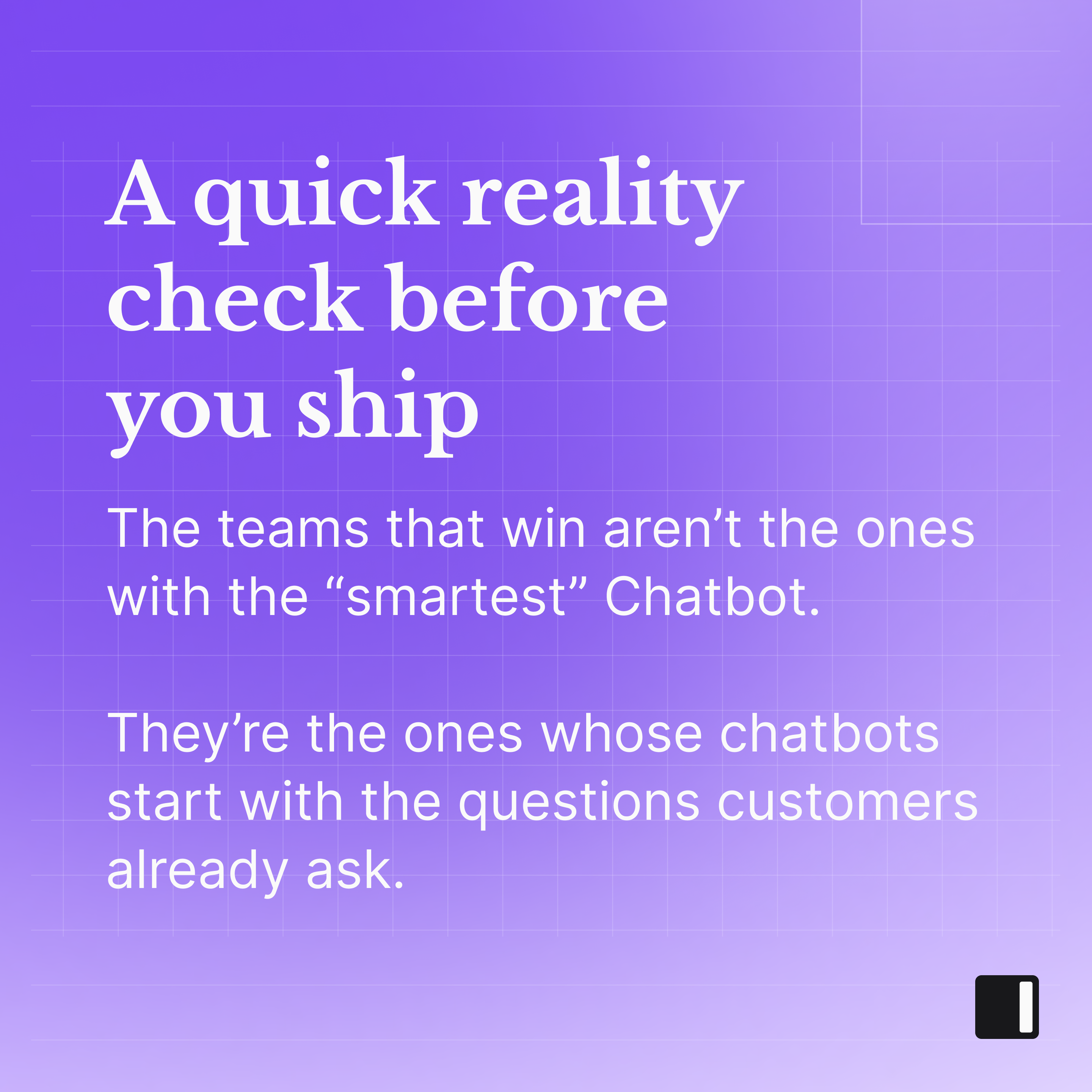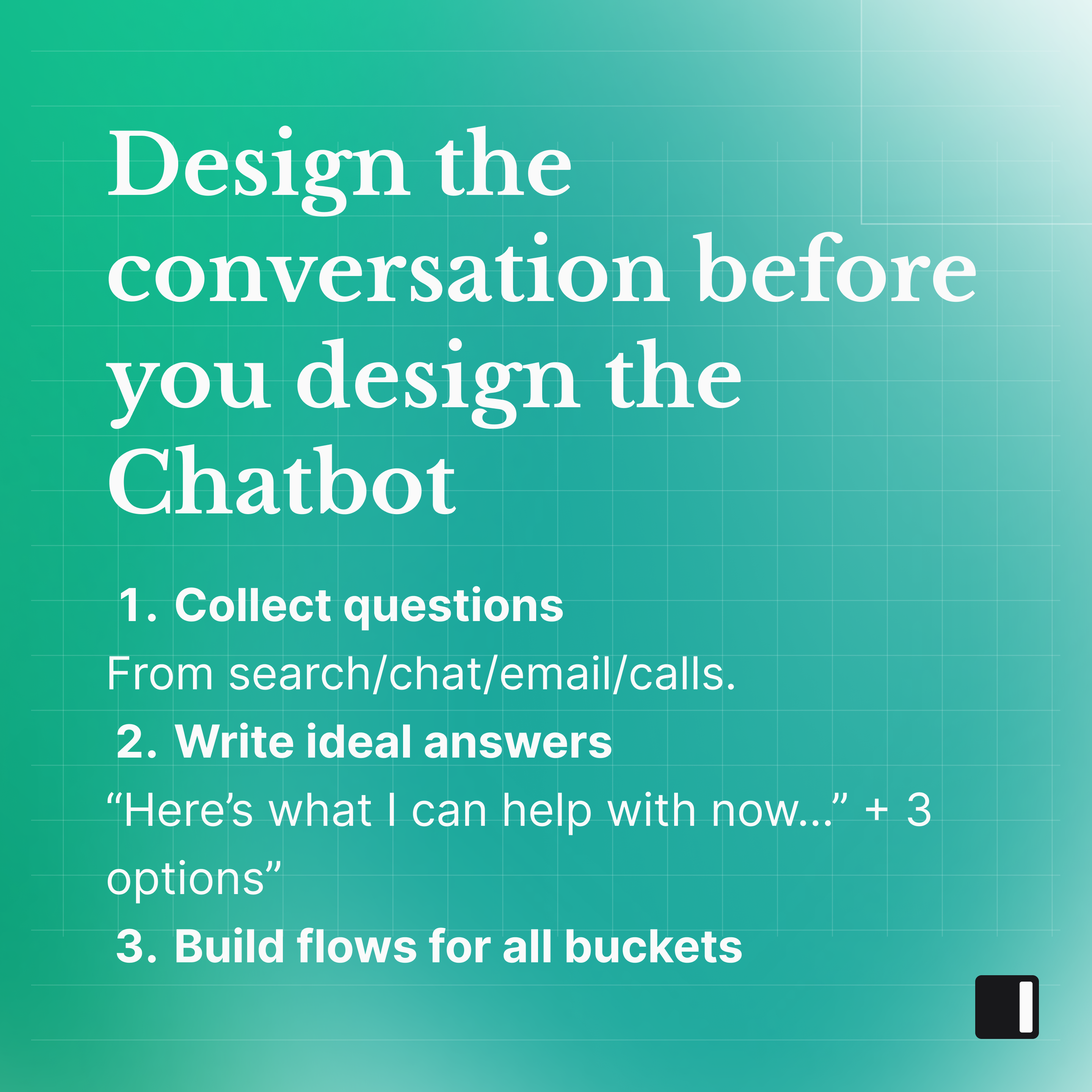TL;DR
Most chatbots fail not because the AI isn’t smart enough, but because they’re not designed around real customer questions.
To build one that works:
- Start with conversations, not technology.
- Collect real customer questions from search, chat, email, and calls.
- Group them into four types: Understanding, How‑to, Comparison/Risk, and Shortcuts.
- Write ideal, human answers before touching any builder.
- Use tools like Invent to turn those flows into a chatbot you can launch, test, and improve.
A reality check before you build
It’s tempting to think the winning chatbot is powered by the most advanced model or a flashy interface. In reality, the best chatbots start with a simpler question:
“What are customers already asking us every day?”
If your chatbot can answer those questions clearly, quickly, and in the customer’s language, you’ll outperform most bots out there. This post walks you through a practical framework to design your chatbot around real user conversations, not guesswork or hype.
You’ll learn:
- Why “design the conversation first” is the right place to start
- The four types of customer questions every chatbot should handle
- How to go from raw questions to working conversation flows
- How to turn those flows into a chatbot you can ship and iterate quickly

Before you launch your chatbot, don’t obsess over making it the “smartest” in the room. Focus on the questions customers already ask every day, support tickets, DMs, emails. The teams that win are the ones whose assistants nail those basics first, then get fancy later.
Step 1: Design the conversation before the chatbot
Conversation design is the foundation of every successful AI chatbot. Think of it as writing the script for your best support or sales teammate.
1. Collect real customer questions
Gather questions from every channel where customers talk to you:
- Search: On-site search logs, help-center keywords
- Chat: Live chat transcripts, chatbot logs, WhatsApp or DM messages
- Email: Support and sales inboxes
- Calls: Notes from support or onboarding calls
Aim for 50–100 unfiltered questions in the customer’s own words—that’s enough to spot patterns and start designing.
2. Bucket questions into four types
Most customer questions fall into one of four buckets:
- Understanding: “What is this? Is it for me?”
Your bot’s job: Explain clearly and help them self‑qualify. - How‑to: “How do I do X right now?”
Your bot’s job: Offer short, step‑by‑step instructions with links or quick actions. - Comparison/Risk: “Is this better or safer than my current option?”
Your bot’s job: Address trust and risk concerns with honest, specific answers. - Shortcuts: “What’s the fastest way to get what I need?”
Your bot’s job: Reduce friction and offer direct routes—view pricing, contact a human, or take an action.
3. Write ideal, human answers
For each key question, write responses like your best teammate would:
- Use plain language, ditch the jargon.
- Start with: “Here’s what I can help with right now…”
- Offer up to three clear next steps or actions.
These responses will later form the building blocks of your chatbot flows.
4. Turn answers into flows
Once you have:
- Real questions
- Organized buckets
- Ideal answers
Build simple, guided flows. Each flow should define:
- Entry points: Triggers (e.g., “What is Invent?” → Understanding bucket)
- Core response: The ideal answer
- Follow‑up options: 2–3 suggested next steps
- Exit condition: When the conversation is complete and where to direct next (link, doc, or human).
This keeps your chatbot focused, fast, and outcome‑driven.
Step 2: Don’t chase “smart”, chase coverage
Teams often obsess over “smart” AI behavior when they should focus on coverage.
A bot that:
- Recognizes these four question types
- Covers the top 50–100 customer questions
- Gives clear, consistent answers
…will outperform an overengineered LLM‑powered bot every time. Think of your chatbot as a routing system + concise expert answers + light AI enhancement, not a fully autonomous agent.
Step 3: Turn your conversation design into a working chatbot
Once your content is ready, choose your tool. With Invent or similar platforms, you can:
- Import help docs, FAQs, and your ideal answers.
- Create flows for each bucket (Understanding, How‑to, Comparison, Shortcuts).
- Map triggers to flows and define when to escalate.
- Track results: containment rate, response time, top unanswered questions.
The setup becomes simple because you’ve already done the thinking that matters.

Before you wire up intents, webhooks, and fancy AI, map the actual conversation 👇 1. Collect real customer questions from search, chat, email, and calls. 2- Write the ideal answers and a clear “Here’s what I can help with now…” + 3 simple options. 3. Turn those into flows.
FAQ: Building better chatbots
1.Do I need to bucket questions?
Yes. Buckets bring structure and predictability. AI can handle edge cases, but the core user experience should follow a clear design.
2. How many questions before launch?
Start with 50–100 questions. Cover them well, launch, and expand with real usage data.
3. What if my product is complex?
Use branching flows and clear options. Start broad, then narrow choices—never rely just on open text. Always give ways to see docs, act, or talk to a human.
4. How do I measure chatbot effectiveness?
Track resolution rate, response time to first useful answer, CSAT/thumbs-up ratings, and repeat unanswered questions.
5. Can I still use large language models?
Absolutely. LLMs fit perfectly as enhancers: generalize across buckets, rewrite ideal answers, or handle fallback questions. But the conversation structure should come from you.
Conclusion: Start with the questions
The best chatbots are just great conversations, turned into repeatable flows.
- Collect real customer questions.
- Write ideal, human‑sounding answers.
- Build clear flows before touching AI or code.
- Launch fast, measure real usage, and refine.
When you start with what customers actually ask, your chatbot doesn’t need to be the smartest, it just needs to be the one that helps.
Ready? Start planning and building your own chatbot on Invent.

